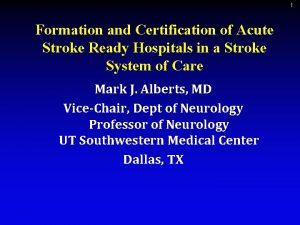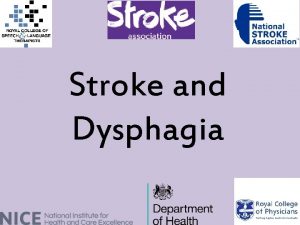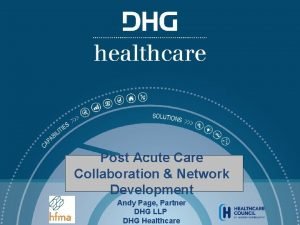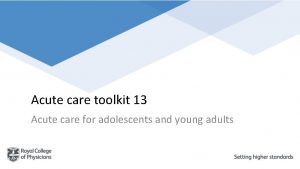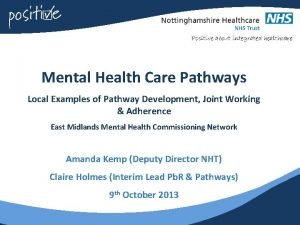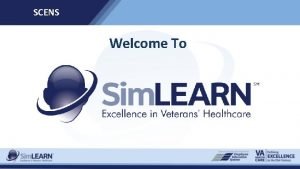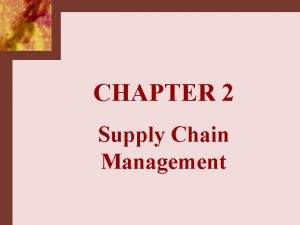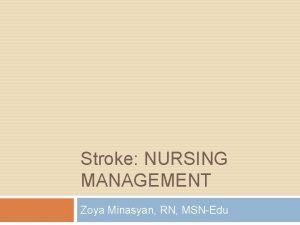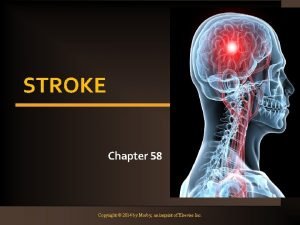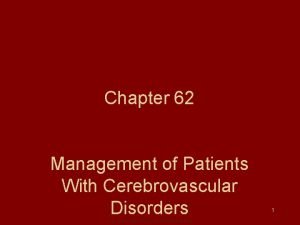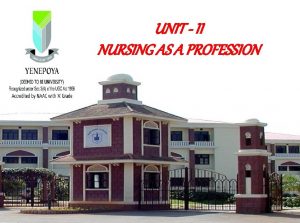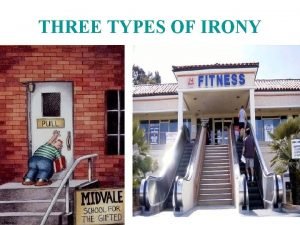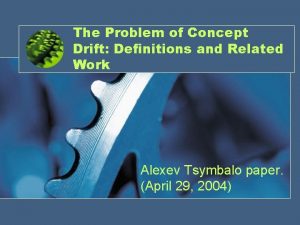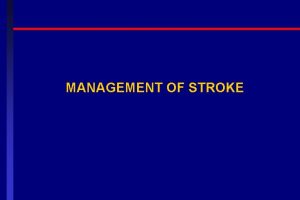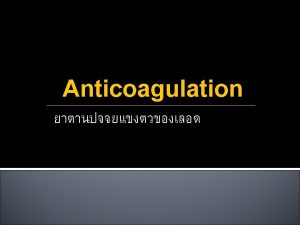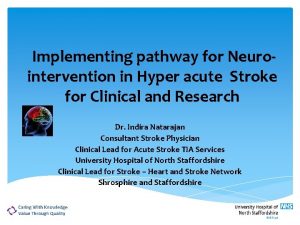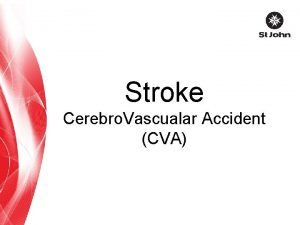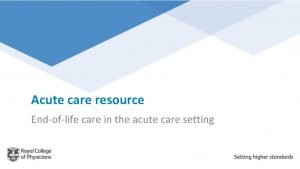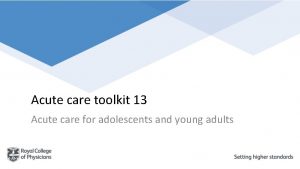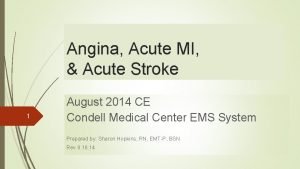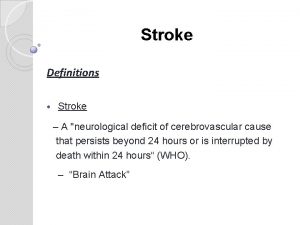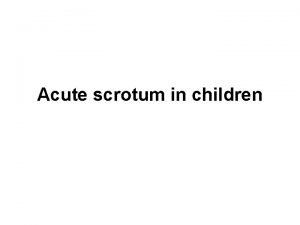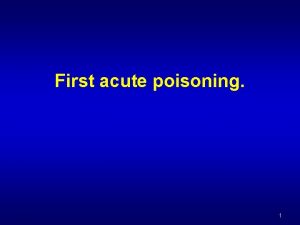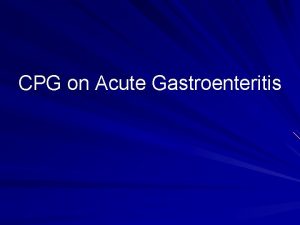MANAGEMENT OF STROKE STROKE ACUTE CARE PATHWAY DEFINITIONS

































- Slides: 33

MANAGEMENT OF STROKE

STROKE ACUTE CARE PATHWAY DEFINITIONS 1. WHO A NEUROLOGICAL DEFICIT OF • Sudden onset • • With focal rather than global dysfunction In which, after adequate investigations, symptoms are presumed to be of non-traumatic vascular origin • and last for >24 hours 2. NINDS 2005 • When the blood supply to part of the brain is suddenly interrupted or when a blood vessel in the brain bursts 3. TIA-neurological deficit of vascular origin lasts from few minutes to hours and resolves within 24 hours

TYPES OF STROKE ISCHEMIC 85% HEMORRHAGIC 15% Stroke Haemorrhage Intraparenchymal Subarachnoid (15%) Atherosclerotic (20%) Penetating artery Disease (lacunar) (25%) Cardioembolic (20%) Cryptogenic (30%) Unusual causes Prothrombotic Dissections Arteritis Migraine Drug abuse (5%)

STROKE ACUTE CARE PATHWAY WHY? v MAJOR GLOBAL PUBLIC HEALTH CONCERN v MAIN CAUSE OF DISABILITY IN ADULTS v SECOND COMMONEST CAUSE OF DEATH (WHO 2003) v FIFTY PERCENT ARE DEPENDENT DAILY ACTIVITIES v AMONG THE TOP 4 CAUSES OF DEATH IN ASEAN COUNTRIES v IN MALAYSIA, 4 TH COMMON CAUSE OF DEATH AFTER SEPTICAEMIA, HEART DISEASE AND CANCER v There are no study reports of either organized stroke care or analysis of outcome in stroke patients, from Malaysia

STROKE ACUTE CARE PATHWAY CHANGING TRENDS…. • Stroke is a preventable and treatable disease • More effective evidence based primary and secondary prevention strategies • Evidence of interventions that are effective soon after the onset of symptoms • Understanding of the care processes that contribute to a better outcome has improved

EVIDENCE BASED PATHWAY • • • ISCHEMIC STROKE IN ADULTS TRANSIENT ISCHEMIC ATTACKS-TIA HEMORRHAGIC STROKE IN ADULTS STROKE IN CHILDREN ANEURYSMAL RUPTURE AVM BLEED

STROKE CONTINUUM PRIMARY PREVENTION OUTPATIENT ACUTE CARE ER REHABILITATION COMMUNITY RE-INTEGRATION SECONDARY PREVENTION

STROKE FLOW Acute Care Pathway MODIFICATIONS 5 COMPONENTS: 1. TIA PATHWAY 2. STROKE – THROMBOLYSIS- ER TO ICU PATHWAY 3. STROKE UNIT CARE 4. NEUROINTERVENTION IN STROKE PATHWAY 5. STROKE SURGERY PATHWAY

STROKE PATHWAY ALGORITHM TIA Suspected TIA EXCLUDE HYPOGLYCEMIA + _ HISTORY AND CONSIDER ALTERNATIVE DIAGNOSIS FAST ROSIER TO ESTABLISH DX TIA STROKE PATHWAY NO COMPLETELY RESOLVED START ASPIRIN 300 MG/DAY ADMIT STROKE UNIT FOR ABCD 2<4 ASSESS RISK OF STROKE ABCD 2>4 SPECIALIST ASSESSMENT & INVESTIGATION IN 24 HRS BEST MEDICAL TREATMENT BRAIN IMAGING WITH MRI WITH DWI START ASPIRIN 300 MG/DAY TO GO HOME SPECIALIST ASSESSMENT & INVESTIGATION IN 1 WEEK NO BEST MEDICALTREATMENT Eg. Control of blood pressure, antiplatelet drugs and cholesterol lowering through diet and drugs and lifestyle changes smoking cessation, exercise regimen etc. ) CAROTID IMAGING if the patient is a candidate for carotid intervention YES <70 -99% Level of symptomatic carotid stenosis ECST >70 -99% CAROTID ENDARTERECTOMY OR ANGIOPLASTY & STENTING

TIA Acute Care Pathway • Use the Face–Arm–Speech Test (FAST) Three simple checks can help you recognise whether someone has had a stroke or mini-stroke (transient ischemic attack – TIA). F -Facial weakness: Can the person smile? Has their mouth or an eye drooped? A -Arm weakness: Can the person raise both arms? S -Speech problems: Can the person speak clearly and understand what you say? T -Test all three signs. REFERENCE : NICE CLINICAL GUIDELINES- STROKE EVIDENCE LEVEL 1 B

Recognition Of Stroke In ER (ROSIER) Has there been loss of consciousness or syncope? YES -1 NO 0 Has there been a seizure? -1 0 Asymmetric facial weakness? 1 0 Asymmetric hand weakness? 1 0 Asymmetric leg weakness? 1 0 Speech disturbance? 1 0 Visual field disturbance? 1 0 Total score ---------------------------------------------------------------------If total score >0 stroke likely - if total score – 2, -1 or 0 stroke unlikely NB : EXCLUDE HYPOGLYCEMIA REFERENCE : NICE CLINICAL GUIDELINES- STROKE EVIDENCE LEVEL 1 B

TIA ABCD 2 Score Symptom Score Age > 60 years 1 point Blood pressure > 140/80 1 point Clinical (neurological deficit) 2 points for hemiparesis 1 point for speech problem without weakness Duration 2 points for >60 minutes 1 point for 10 -60 min Diabetes 1 point Maximal score is 7. REFERENCE: Rothwell et al, Lancet. 2007; 369: 283 -92 EVIDENCE LEVEL 3

TIA • People who have had a suspected TIA who are at lower risk of stroke ABCD 2 score of 3 or below: should have • aspirin (300 mg daily) started immediately • specialist assessment and investigation as soon as possible, but definitely within 1 week of onset of symptoms • measures for secondary prevention introduced as soon as the diagnosis is confirmed, including discussion of individual risk NB: People who have had a TIA but who present late (more than 1 week after their last symptom has resolved) should be treated as though they are at lower risk of stroke. REFERENCE : NICE CLINICAL GUIDELINES- STROKE

TIA • People who have had a suspected TIA who are at high risk of stroke TIAs with ABCD 2 score ≥ 4 or above should have: • aspirin (300 mg daily) started immediately • specialist assessment and investigation within 24 hours of onset of symptoms • measures for secondary prevention introduced as soon as the diagnosis is confirmed, including discussion of individual risk • TIAS with a score of 5 or greater to be admitted for immediate Ix and Tx (within 24 h). REFERENCE : NICE CLINICAL GUIDELINES- STROKE EVIDENCE LEVEL 3

Carotid Endarterectomy Pooled Reanalysis of ECST and NASCET data Almost 6000 patients For patients with 50% or higher stenosis, the number of patients needed to undergo surgery (ie, number needed to treat) to prevent one ipsilateral stroke in 5 years was • • • 9 for men versus 36 for women 5 for age 75 years or older versus 18 for younger than 65 years 5 for those randomized within 2 weeks after their last ischaemic event, versus 125 for patients randomized after more than 12 weeks. Benefit from surgery was greatest in men, patients aged 75 years or older, and those randomized within 2 weeks after their last ischemic event, and fell rapidly with increasing delay. REFERENCE : EVIDENCE Lancet 2004; 363: 915 -924 LEVEL 1 ++

PATHWAY ALGORITHM- I STROKE Establish a diagnosis rapidly using a validated tool, - ROSIER NIHSS Score Assessment for IMMEDIATE brain scanning SUSPECTED STROKE Exclude hypoglycaemia STROKE MIMICS +VE Face Arm Speech Test (FAST) to screen -VE Consider alternative diagnosis (stroke remains a possible diagnosis) NO Scan as soon as possible (within 24 hours) YES MRI YES NO INDICATIONS FOR THROMBOLYSE IV r TPA <3 HRS r. TPA ADMIT TO STROKE UNIT* for SPECIALIST CARE DEPARTMENT OF NEUROANAESTHESIA & INTENSIVE CARE * YES > 3 HRS *GENERAL CARE REFER TO INTERVENTIONAL NEURORADIOLOGY • I A r TPA • MERCI ICU STROKE PATHWAY *MULTIDISCIPLINARY SPECIALIST STROKE TEAM NEUROPROTECTION Rx of COMPLICATION OF r TPA NEUROSURGERY REFERRAL

ACUTE CARE PATHWAY • STROKE UNIT • Organised inpatient (stroke unit) care for stroke The Cochrane Database of Systematic Reviews Organised inpatient (stroke unit) care for stroke: • • • Organised stroke unit care is a form of care provided in hospital by nurses, doctors and therapists who specialise in looking after stroke patients and work as a co-ordinated team. This review of 31 trials, involving 6936 participants, showed that patients who receive this care more likely to survive their stroke, return home and become independent in looking after themselves. A variety of different types of stroke unit have been developed. The best results appear to come from those which are based in a dedicated ward. OUTCOME: EVIDENCE LEVEL : 2+ A RCT= 304 : 1+ LENGTH OF STAY: COCHRANE REVIEW: 1++

STROKE Acute Care Pathway Administration of r. TPA ‘CLOT BUSTER’ Main eligibility criteria § § FOR IV INFUSION Treatment given within 3 hrs) Intracranial bleeding excluded Age <80 Early major infarction excluded (parenchyma hypo-attenuation or brain swelling >1/3 rd MCA territory) § § NIHSS SCORE <22 MRS ≥ 2 § § BP < 185/110 Not on warfarin or heparin, platelets and coagulation normal § § Treatment given by a specially trained physician Facilities for close monitoring

RECOMMENDATIONS: STROKE UNIT • Every hospital should have a stroke unit • A stroke should be managed by a multidisciplinary stroke team • An efficient referral and rehabilitation system to be established for the success of a stroke unit • Stroke units significantly reduce death, dependency, institutionalisation and length of hospital stay. OUTCOME: EVIDENCE LEVEL : 2+ A RCT= 304 : 1+ LENGTH OF STAY: COCHRANE REVIEW: 1++

PATHWAY ALGORITHM - II STROKE - SURGERY Patient Admitted in STROKE UNIT TYPE OF STROKE HEMORRHAGIC ISCHEMIC surgical referral for Decompression indicated ? WITH / WITHOUT HYDROCEPHALUS YES INDICATION S FOR DECOMPRESSIVE CRANIECTOMY(1) NO YES DECOMPRESS AS EARLY AS POSSIBLE 1. 2. 3. REFER IMMEDIATELY CONTINUE MEDICAL TREATMENT INDICATIONS FOR EVACUATION OF HEMATOMA STOMY/ BOTH / VENTRICULO YES NO CONSIDER SURGICAL INTERVENTION DECIMAL TRIAL STICH II TRIAL MISTIE TRIAL EVACUATION BY CRANIOTOMY (2) NEUROREHAB Medical treatment prior to discharge: • cholesterol lowering • BP control • dietary advice • antiplatelet treatment • lifestyle advice. EVACUATION BY MINIMAL INVASIVE TECHNIQUES(3) VENTRICULOSTOMY/ EVD CLOSURE

STROKE SURGERY HEMORRHAGIC A. Lobar hemorrhage 1. STICH Trial -Mendelow AD et al. Lancet 2005, RCT, -No difference in outcome in stable patients -Surgery Outcome better than conservative RX in progressive Neurological deterioration. Evidence Level 1++ B. Basal ganglia Hemorrhage 1. . Endoscopy Evacuation better than conservative treatment, Vol. > 50 cc, age < 50 years Evidence Level 1+ C. Cerebellar Hemorrhage with obstructive hydrocephalus Surgical Emergency

Stroke Surgery Surgical Treatment Of Intracerebral Hemorrhage The International STICH Trial • Spontaneous ICH < 72 hrs • GCS > 5, Diameter > 2 cm • Age > 14 yrs R • Craniotomy/Evacuation • 500 patients • Conservative Med Control • 500 patients Design • • 83 Centers • • Goal: 1000 patients • • Inclusion: Supratentorial hemorrhage only, uncertainty on need to operate • • Exclusions: severe pre-ICH disability or systemic disease, IVH, BGH • • Outcome: GOS, BI, RS at 6 months • • Funding: UK Stroke Association, UK Medical Research Council • • Coordinating Center: Dept Neurosurgery, Newcastle upon Tyne, UK David Mendelow, MD The Lancet Feb 2005

UROKINASE OR TPA INSTILATION AND ASPIRATION THROMBOLYSIS WITH UK / TPA AND MINIMAL INVASIVE EVACUATION- PHASE II

STROKE SURGERY ISCHEMIC People with middle cerebral artery (MCA) infarction who meet all of the criteria below should be considered for decompressive hemicraniectomy. • They should be referred within 24 hours of onset of symptoms and • treated within a maximum of 48 hours: • aged 60 years or under • clinical deficits suggestive of infarction in the territory of the MCA with a score on the • National Institute of Health Stroke Scale (NIHSS) of above 15 • decrease in the level of consciousness to give a score of 1 or more on item 1 a of the NIHSS • signs on MRI of an infarct of at least 50% of the MCA territory, with or without additional • infarction in the territory of the anterior or posterior cerebral artery on the same side, or • infarct volume greater than 145 cm 3 as shown on diffusion-weighted MRI. • • DECIMAL TRIAL- RCT - Stroke. 2007; 38: 2506. ) EVIDENCE LEVEL 1+

DECIMAL TRIAL-RESULT Decompressive Craniectomy in Malignant MCA infarction • Thirty-eight patients from 7 stroke centers had been enrolled in the DECIMAL trial when it was prematurely stopped on recommendation from the data safety monitoring committee. On the basis of interim data, the data safety monitoring committee recommended first, to stop the trial, mainly because of slow recruitment and a high difference in mortality between the 2 groups, and • second, to organize a pooled analysis of the individual data from DECIMAL and the 2 other ongoing European randomized trials of decompressive craniectomy in malignant MCA infarction (DESTINY and HAMLET).

STROKE PATHWAYS RESOURCES: 1. National clinical guidelines for stroke Clinical Effectiveness& Evaluation Unit ROYAL COLLEGE OF PHYSICIANS 2. STROKE National clinical guideline for diagnosis and initial management of acute stroke and transient ischaemic attack ROYAL COLLEGE OF PHYSICIANS 3. Stroke: Diagnosis and initial management of acute stroke and transient ischaemic attack (TIA) National Institute of clinical Excellence and Health clinical guideline (NICE)

LEVELS OF EVIDENCE


LEVELS OF EVIDENCE- PRIMARY RISK FACTORS

LEVELS OF EVIDENCE- PHARMACOTHERAPY

LEVELS OF EVIDENCE Neurosurgery Interventional Neuroradiology

STROKE ACUTE CARE HOW? PREHOSPITAL CARE EARLY DETECTION RAPID DISPATCH INTENSIVE CARE STROKE UNIT MULTIDISCIPLINARY TEAM NEURO REHABILITATION IDENTIFY RISK FACTORS PHYSICAL THERAPY OCCUPATIONAL THERAPY SPEECH AND LANGUAGE THERAPY PSYCHOLOGY EVIDENCE BASED PATHWAY CHRONIC CARE

Thank you for your attention
 Stroke protocol
Stroke protocol Acute stroke ready certification
Acute stroke ready certification Nice stroke pathway
Nice stroke pathway Anterior stroke vs posterior stroke
Anterior stroke vs posterior stroke Levels of care primary secondary tertiary quaternary
Levels of care primary secondary tertiary quaternary Post-acute care collaboration
Post-acute care collaboration Rcp acute care toolkit
Rcp acute care toolkit Patho
Patho Example of health care pathways
Example of health care pathways Stroke fast assessment
Stroke fast assessment Cscmp definition of supply chain management
Cscmp definition of supply chain management Objective of marketing manager
Objective of marketing manager Meaning of management accounting
Meaning of management accounting Definition of financial management
Definition of financial management Financial management meaning
Financial management meaning Nursing management of chronic pancreatitis
Nursing management of chronic pancreatitis Nursing management of stroke
Nursing management of stroke Nursing management of stroke
Nursing management of stroke Nursing management of stroke
Nursing management of stroke Duty of care outcome care certificate
Duty of care outcome care certificate Magneții atrag corpuri care conțin
Magneții atrag corpuri care conțin Palliative care vs hospice care
Palliative care vs hospice care Cum se numesc animalele care fac oua
Cum se numesc animalele care fac oua Care sunt simturile prin care sunt evocate
Care sunt simturile prin care sunt evocate Care certificate standard 13 answers
Care certificate standard 13 answers Hip fracture care clinical care standard
Hip fracture care clinical care standard Health and social care values unit 2
Health and social care values unit 2 Top management middle management first line management
Top management middle management first line management Top management middle management first line management
Top management middle management first line management Basic concepts of management
Basic concepts of management Definition of nursing
Definition of nursing Different types of irony
Different types of irony The problem of concept drift: definitions and related work
The problem of concept drift: definitions and related work The correct shutoff procedure for an oxyacetylene torch is:
The correct shutoff procedure for an oxyacetylene torch is:

